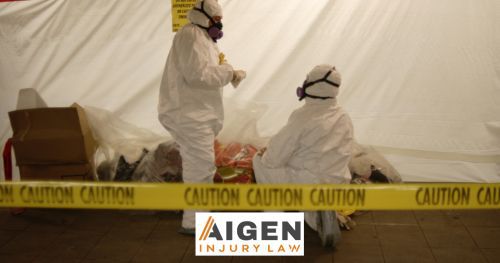
Once praised for its fire-resistant and insulating properties, asbestos has since been linked to serious health risks. Construction workers remain particularly vulnerable due to frequent contact with asbestos-containing materials in older structures, often hidden in insulation and flooring.
Despite increased awareness and stricter regulations, workers in Florida and across the U.S. continue to face exposure risks on the job. Understanding the dangers of asbestos exposure and the legal recourse available is crucial for any worker who believes their illness may be linked to this hazardous material.
If you or a loved one has been affected, consult a Miami construction injury lawyer from Aigen Injury Law, who can provide you the guidance needed to pursue compensation.
How Asbestos Is Found in the Construction Industry
Asbestos, a naturally occurring mineral, was extensively used in the construction industry for many years because of its strength, heat resistance, and insulating qualities. It was commonly used in various building materials, including:
- Wrapped around pipes, boilers, and electrical wiring for insulation.
- In flooring and roofing materials, including tiles, shingles, and other coverings in older buildings.
- Incorporated into cement sheets and drywall compounds to add strength and fire resistance.
- Applied as a fireproofing material on steel beams and other structural components to slow the spread of fires.
Although the use of asbestos in new construction has decreased due to health regulations, it is still commonly found in buildings constructed before the early 1970s. Renovation, demolition, or routine maintenance work in these structures can release asbestos fibers into the air, putting workers at risk of inhalation.
How Asbestos Exposure Can Injure Construction Workers
Asbestos is hazardous when its tiny fibers are disrupted and enter the air. Workers who handle asbestos-containing materials through cutting, drilling, sanding, or demolition work can unknowingly inhale these fibers. Once inhaled, asbestos fibers can become lodged in the lungs or other tissues, leading to severe health conditions over time.
Common asbestos-related illnesses include:
- Mesothelioma: An often-fatal form of cancer, mesothelioma targets the lining of the heart, lungs, or abdomen. It’s predominantly caused by asbestos exposure, with around 80% of cases linked to it. Sadly, the disease can remain dormant for 20-50 years before symptoms appear.
- Asbestosis: Asbestosis is a long-term lung disease resulting from asbestos fibers scarring lung tissue. It leads to serious respiratory problems, including difficulty breathing, a constant cough, and chest pain. There is no cure, and the condition worsens as time goes on.
- Lung Cancer: Asbestos exposure can increase the risk of developing various forms of lung cancer. Research has found that adenocarcinoma (a type of cancer that forms in the glands lining the lungs and other organs) accounts for 45% of asbestos-related lung cancer cases, followed by squamous cell carcinoma (a type of lung cancer where tumors form in the main airways) at 42%.
- Pleural Effusions and Pleural Plaques: These non-cancerous lesions affect the lining of the lungs, causing fluid buildup (pleural effusion) or thickened patches (pleural plaques). These conditions can cause discomfort and indicate a higher risk of developing more serious asbestos-related diseases.
Legal Recourse and Resources for Affected Workers in Florida
A diagnosis of mesothelioma, asbestosis, or another asbestos-related illness can severely affect your health and finances, leading to high medical costs and lost income. If you’ve been diagnosed with an asbestos-related condition, a Florida work injury attorney can help you explore the following legal options for compensation:
| Compensation Option | Description | Considerations |
| Workers’ Compensation | Workers’ comp benefits include medical bills, partial lost wages, and disability benefits. | Claims can become complicated when the exposure occurred years previously or across multiple sites. A lawyer can help maximize benefits. |
| Personal Injury Lawsuits | Compensation for medical expenses, lost wages, pain and suffering, and other damages. | You’ll need to show your employer knew about asbestos risks and failed to protect workers. Your attorney can help gather evidence and build your case for damages. |
| Third-Party Claims | Compensation from contractors, property owners, or others for unsafe asbestos exposure. | Can be filed alongside workers’ comp or personal injury claims. You’ll need to prove negligence from third parties. |
| Social Security Disability (SSDI) | Monthly disability payments for those unable to work due to asbestos-related illness. | You must show your illness prevents you from working. The approval process can be long and might require appeals, which your attorney can assist with. |
| Asbestos Trust Funds | Additional compensation from established asbestos manufacturer funds. | These funds are tied to individual companies that used asbestos. A lawyer can help you file claims with specific companies to access compensation. |
Contact a Miami Construction Injury Lawyer for Assistance
When dealing with health complications from asbestos exposure, you need the help of an experienced Miami construction injury lawyer who understands the medical and legal aspects of these cases. At Aigen Injury Law, we help injured workers secure the compensation they deserve and hold negligent parties accountable.
Our experienced mesothelioma lawyers can work with medical specialists and occupational health experts to prove the extent of your illness and connect it to asbestos exposure. With these insights, we can maximize your settlement and help ensure coverage for current and future medical needs and treatments.
Contact us today for a free consultation to discuss your case and learn about your legal rights and options.
Since the early 1970s, use of asbestos has declined substantially; mining of asbestos ceased in the United States in 2002, though some asbestos continues to be imported [NIOSH 2011a].
Asbestos is still used in some construction materials. Some previously marketed asbestos-containing products, such as amphibole-contaminated vermiculite insulation, remain in many homes and other buildings in the United States.